Ying Wen
Embodied Arena: A Comprehensive, Unified, and Evolving Evaluation Platform for Embodied AI
Sep 18, 2025Abstract:Embodied AI development significantly lags behind large foundation models due to three critical challenges: (1) lack of systematic understanding of core capabilities needed for Embodied AI, making research lack clear objectives; (2) absence of unified and standardized evaluation systems, rendering cross-benchmark evaluation infeasible; and (3) underdeveloped automated and scalable acquisition methods for embodied data, creating critical bottlenecks for model scaling. To address these obstacles, we present Embodied Arena, a comprehensive, unified, and evolving evaluation platform for Embodied AI. Our platform establishes a systematic embodied capability taxonomy spanning three levels (perception, reasoning, task execution), seven core capabilities, and 25 fine-grained dimensions, enabling unified evaluation with systematic research objectives. We introduce a standardized evaluation system built upon unified infrastructure supporting flexible integration of 22 diverse benchmarks across three domains (2D/3D Embodied Q&A, Navigation, Task Planning) and 30+ advanced models from 20+ worldwide institutes. Additionally, we develop a novel LLM-driven automated generation pipeline ensuring scalable embodied evaluation data with continuous evolution for diversity and comprehensiveness. Embodied Arena publishes three real-time leaderboards (Embodied Q&A, Navigation, Task Planning) with dual perspectives (benchmark view and capability view), providing comprehensive overviews of advanced model capabilities. Especially, we present nine findings summarized from the evaluation results on the leaderboards of Embodied Arena. This helps to establish clear research veins and pinpoint critical research problems, thereby driving forward progress in the field of Embodied AI.
A Survey of AI Agent Protocols
Apr 23, 2025Abstract:The rapid development of large language models (LLMs) has led to the widespread deployment of LLM agents across diverse industries, including customer service, content generation, data analysis, and even healthcare. However, as more LLM agents are deployed, a major issue has emerged: there is no standard way for these agents to communicate with external tools or data sources. This lack of standardized protocols makes it difficult for agents to work together or scale effectively, and it limits their ability to tackle complex, real-world tasks. A unified communication protocol for LLM agents could change this. It would allow agents and tools to interact more smoothly, encourage collaboration, and triggering the formation of collective intelligence. In this paper, we provide a systematic overview of existing communication protocols for LLM agents. We classify them into four main categories and make an analysis to help users and developers select the most suitable protocols for specific applications. Additionally, we conduct a comparative performance analysis of these protocols across key dimensions such as security, scalability, and latency. Finally, we explore future challenges, such as how protocols can adapt and survive in fast-evolving environments, and what qualities future protocols might need to support the next generation of LLM agent ecosystems. We expect this work to serve as a practical reference for both researchers and engineers seeking to design, evaluate, or integrate robust communication infrastructures for intelligent agents.
AFiRe: Anatomy-Driven Self-Supervised Learning for Fine-Grained Representation in Radiographic Images
Apr 15, 2025



Abstract:Current self-supervised methods, such as contrastive learning, predominantly focus on global discrimination, neglecting the critical fine-grained anatomical details required for accurate radiographic analysis. To address this challenge, we propose an Anatomy-driven self-supervised framework for enhancing Fine-grained Representation in radiographic image analysis (AFiRe). The core idea of AFiRe is to align the anatomical consistency with the unique token-processing characteristics of Vision Transformer. Specifically, AFiRe synergistically performs two self-supervised schemes: (i) Token-wise anatomy-guided contrastive learning, which aligns image tokens based on structural and categorical consistency, thereby enhancing fine-grained spatial-anatomical discrimination; (ii) Pixel-level anomaly-removal restoration, which particularly focuses on local anomalies, thereby refining the learned discrimination with detailed geometrical information. Additionally, we propose Synthetic Lesion Mask to enhance anatomical diversity while preserving intra-consistency, which is typically corrupted by traditional data augmentations, such as Cropping and Affine transformations. Experimental results show that AFiRe: (i) provides robust anatomical discrimination, achieving more cohesive feature clusters compared to state-of-the-art contrastive learning methods; (ii) demonstrates superior generalization, surpassing 7 radiography-specific self-supervised methods in multi-label classification tasks with limited labeling; and (iii) integrates fine-grained information, enabling precise anomaly detection using only image-level annotations.
ReMA: Learning to Meta-think for LLMs with Multi-Agent Reinforcement Learning
Mar 12, 2025Abstract:Recent research on Reasoning of Large Language Models (LLMs) has sought to further enhance their performance by integrating meta-thinking -- enabling models to monitor, evaluate, and control their reasoning processes for more adaptive and effective problem-solving. However, current single-agent work lacks a specialized design for acquiring meta-thinking, resulting in low efficacy. To address this challenge, we introduce Reinforced Meta-thinking Agents (ReMA), a novel framework that leverages Multi-Agent Reinforcement Learning (MARL) to elicit meta-thinking behaviors, encouraging LLMs to think about thinking. ReMA decouples the reasoning process into two hierarchical agents: a high-level meta-thinking agent responsible for generating strategic oversight and plans, and a low-level reasoning agent for detailed executions. Through iterative reinforcement learning with aligned objectives, these agents explore and learn collaboration, leading to improved generalization and robustness. Experimental results demonstrate that ReMA outperforms single-agent RL baselines on complex reasoning tasks, including competitive-level mathematical benchmarks and LLM-as-a-Judge benchmarks. Comprehensive ablation studies further illustrate the evolving dynamics of each distinct agent, providing valuable insights into how the meta-thinking reasoning process enhances the reasoning capabilities of LLMs.
Retrieval Dexterity: Efficient Object Retrieval in Clutters with Dexterous Hand
Feb 26, 2025Abstract:Retrieving objects buried beneath multiple objects is not only challenging but also time-consuming. Performing manipulation in such environments presents significant difficulty due to complex contact relationships. Existing methods typically address this task by sequentially grasping and removing each occluding object, resulting in lengthy execution times and requiring impractical grasping capabilities for every occluding object. In this paper, we present a dexterous arm-hand system for efficient object retrieval in multi-object stacked environments. Our approach leverages large-scale parallel reinforcement learning within diverse and carefully designed cluttered environments to train policies. These policies demonstrate emergent manipulation skills (e.g., pushing, stirring, and poking) that efficiently clear occluding objects to expose sufficient surface area of the target object. We conduct extensive evaluations across a set of over 10 household objects in diverse clutter configurations, demonstrating superior retrieval performance and efficiency for both trained and unseen objects. Furthermore, we successfully transfer the learned policies to a real-world dexterous multi-fingered robot system, validating their practical applicability in real-world scenarios. Videos can be found on our project website https://ChangWinde.github.io/RetrDex.
PMAT: Optimizing Action Generation Order in Multi-Agent Reinforcement Learning
Feb 23, 2025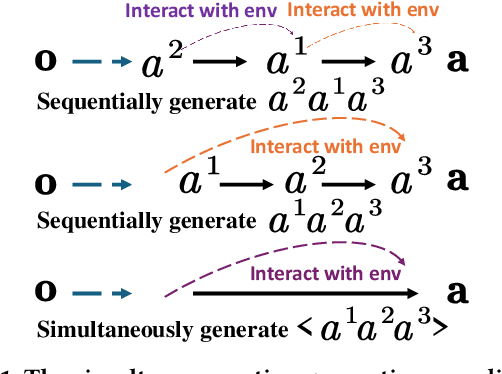
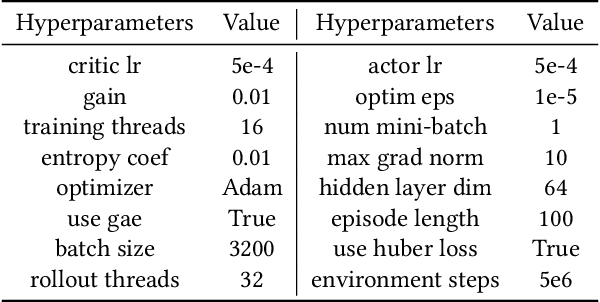

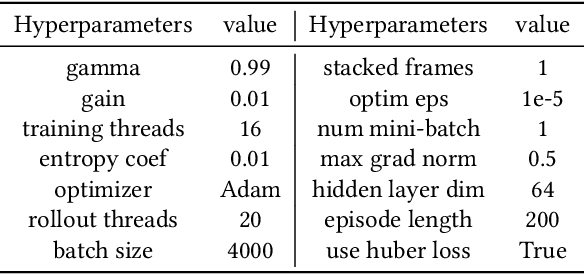
Abstract:Multi-agent reinforcement learning (MARL) faces challenges in coordinating agents due to complex interdependencies within multi-agent systems. Most MARL algorithms use the simultaneous decision-making paradigm but ignore the action-level dependencies among agents, which reduces coordination efficiency. In contrast, the sequential decision-making paradigm provides finer-grained supervision for agent decision order, presenting the potential for handling dependencies via better decision order management. However, determining the optimal decision order remains a challenge. In this paper, we introduce Action Generation with Plackett-Luce Sampling (AGPS), a novel mechanism for agent decision order optimization. We model the order determination task as a Plackett-Luce sampling process to address issues such as ranking instability and vanishing gradient during the network training process. AGPS realizes credit-based decision order determination by establishing a bridge between the significance of agents' local observations and their decision credits, thus facilitating order optimization and dependency management. Integrating AGPS with the Multi-Agent Transformer, we propose the Prioritized Multi-Agent Transformer (PMAT), a sequential decision-making MARL algorithm with decision order optimization. Experiments on benchmarks including StarCraft II Multi-Agent Challenge, Google Research Football, and Multi-Agent MuJoCo show that PMAT outperforms state-of-the-art algorithms, greatly enhancing coordination efficiency.
ThinkBench: Dynamic Out-of-Distribution Evaluation for Robust LLM Reasoning
Feb 22, 2025Abstract:Evaluating large language models (LLMs) poses significant challenges, particularly due to issues of data contamination and the leakage of correct answers. To address these challenges, we introduce ThinkBench, a novel evaluation framework designed to evaluate LLMs' reasoning capability robustly. ThinkBench proposes a dynamic data generation method for constructing out-of-distribution (OOD) datasets and offers an OOD dataset that contains 2,912 samples drawn from reasoning tasks. ThinkBench unifies the evaluation of reasoning models and non-reasoning models. We evaluate 16 LLMs and 4 PRMs under identical experimental conditions and show that most of the LLMs' performance are far from robust and they face a certain level of data leakage. By dynamically generating OOD datasets, ThinkBench effectively provides a reliable evaluation of LLMs and reduces the impact of data contamination.
Retrieval-Augmented Process Reward Model for Generalizable Mathematical Reasoning
Feb 20, 2025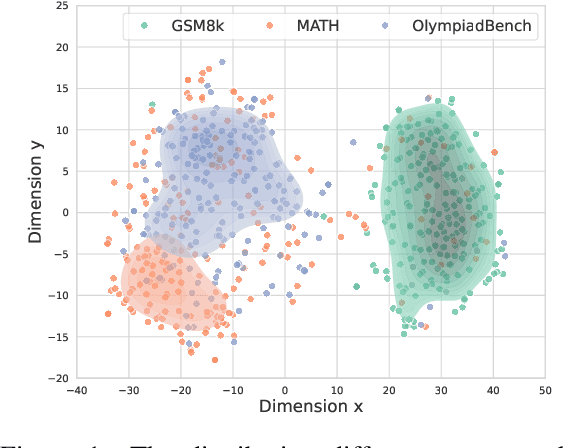
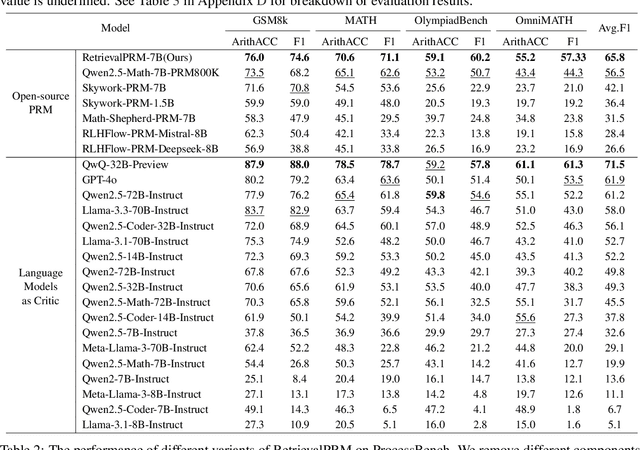
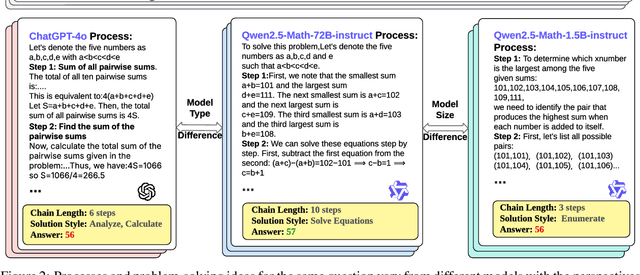

Abstract:While large language models (LLMs) have significantly advanced mathematical reasoning, Process Reward Models (PRMs) have been developed to evaluate the logical validity of reasoning steps. However, PRMs still struggle with out-of-distribution (OOD) challenges. This paper identifies key OOD issues, including step OOD, caused by differences in reasoning patterns across model types and sizes, and question OOD, which arises from dataset shifts between training data and real-world problems. To address these issues, we introduce Retrieval-Augmented Process Reward Model (RetrievalPRM), a novel framework designed to tackle these OOD issues. By utilizing a two-stage retrieval-enhanced mechanism, RetrievalPRM retrieves semantically similar questions and steps as a warmup, enhancing PRM's ability to evaluate target steps and improving generalization and reasoning consistency across different models and problem types. Our extensive experiments demonstrate that RetrievalPRM outperforms existing baselines across multiple real-world datasets. Our open-source contributions include a retrieval-enhanced dataset, a tuning framework for PRM training, and the RetrievalPRM model, establishing a new standard for PRM performance.
RHINO: Learning Real-Time Humanoid-Human-Object Interaction from Human Demonstrations
Feb 18, 2025



Abstract:Humanoid robots have shown success in locomotion and manipulation. Despite these basic abilities, humanoids are still required to quickly understand human instructions and react based on human interaction signals to become valuable assistants in human daily life. Unfortunately, most existing works only focus on multi-stage interactions, treating each task separately, and neglecting real-time feedback. In this work, we aim to empower humanoid robots with real-time reaction abilities to achieve various tasks, allowing human to interrupt robots at any time, and making robots respond to humans immediately. To support such abilities, we propose a general humanoid-human-object interaction framework, named RHINO, i.e., Real-time Humanoid-human Interaction and Object manipulation. RHINO provides a unified view of reactive motion, instruction-based manipulation, and safety concerns, over multiple human signal modalities, such as languages, images, and motions. RHINO is a hierarchical learning framework, enabling humanoids to learn reaction skills from human-human-object demonstrations and teleoperation data. In particular, it decouples the interaction process into two levels: 1) a high-level planner inferring human intentions from real-time human behaviors; and 2) a low-level controller achieving reactive motion behaviors and object manipulation skills based on the predicted intentions. We evaluate the proposed framework on a real humanoid robot and demonstrate its effectiveness, flexibility, and safety in various scenarios.
Leveraging Dual Process Theory in Language Agent Framework for Real-time Simultaneous Human-AI Collaboration
Feb 17, 2025Abstract:Agents built on large language models (LLMs) have excelled in turn-by-turn human-AI collaboration but struggle with simultaneous tasks requiring real-time interaction. Latency issues and the challenge of inferring variable human strategies hinder their ability to make autonomous decisions without explicit instructions. Through experiments with current independent System 1 and System 2 methods, we validate the necessity of using Dual Process Theory (DPT) in real-time tasks. We propose DPT-Agent, a novel language agent framework that integrates System 1 and System 2 for efficient real-time simultaneous human-AI collaboration. DPT-Agent's System 1 uses a Finite-state Machine (FSM) and code-as-policy for fast, intuitive, and controllable decision-making. DPT-Agent's System 2 integrates Theory of Mind (ToM) and asynchronous reflection to infer human intentions and perform reasoning-based autonomous decisions. We demonstrate the effectiveness of DPT-Agent through further experiments with rule-based agents and human collaborators, showing significant improvements over mainstream LLM-based frameworks. To the best of our knowledge, DPT-Agent is the first language agent framework that achieves successful real-time simultaneous human-AI collaboration autonomously. Code of DPT-Agent can be found in https://github.com/sjtu-marl/DPT-Agent.
 Add to Chrome
Add to Chrome Add to Firefox
Add to Firefox Add to Edge
Add to Edge